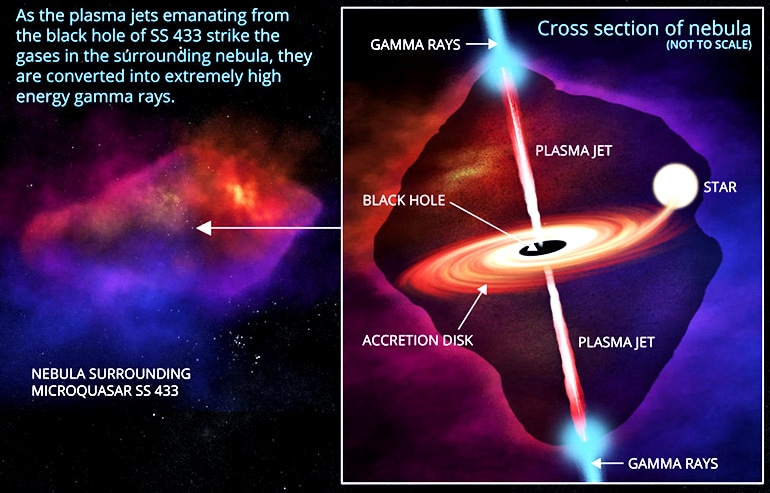Researchers have, for the first time, detected extremely high-energy gamma rays from a powerful star system—a microquasar known as SS 433.
The discovery marks the most energetic radiation researchers have ever detected from a microquasar in our galaxy and will help scientists better understand some of the astrophysical processes happening in deep space, says Segev BenZvi, an assistant professor of physics at the University of Rochester.
“There are only a handful of sources that we know of in the galaxy that can produce particles that have energy this high,” he says.

Studying this system may also offer a glimpse into the extremes of our universe, shedding light on star systems in other distant galaxies, while also supplementing data Earth-bound laboratories gather.
A ‘weird’ system
When scientists discovered the star system SS 433 in 1979, they “very quickly realized that it’s one of the weirdest star systems in the Milky Way,” BenZvi says.
Located 18,000 light years from Earth, the system is composed of a massive star—about 30 times the mass of the sun—that is in close orbit with a “compact object,” which scientists believe is either a neutron star or a black hole.
The compact object sucks in material—mostly gas—from its companion star and converts the material into two powerful jets of plasma that spew in opposite directions from the center of the system. This kind of binary system, characterized by the jets of plasma, is known as a microquasar.
Surrounding the microquasar is a nebula—a cloud of interstellar gas—that is shaped like a football. The researchers found that when the jets of plasma crash into the nebula, the particles speed up, generating high-energy gamma rays.
“The electrons in the jets attain energies thousands of times higher than anything that can be created artificially with Earth-bound accelerators.”
The gamma rays cascade down to Earth, where water-filled tanks at the HAWC facility in Mexico detect them. The gamma rays the HAWC Observatory recently recorded distinguish SS 433 as one of the “most powerful accelerators in the Milky Way,” says Chang Rho, a PhD student of BenZvi’s. “The electrons in the jets attain energies thousands of times higher than anything that can be created artificially with Earth-bound accelerators.”
Until now, however, researchers have not been able to observe very high-energy radiation from the system. Part of what made the analysis challenging is that SS 433 is right next to a pulsar that also emits gamma rays.
“It’s a tricky analysis because you have to subtract all the contamination from this object,” says Rho, who worked on the data analysis and developed a method to separate SS 433’s gamma ray emissions from its close-by neighbors.
Filling in the puzzle
SS 433 is interesting to scientists not only because of its ability to powerfully accelerate particles, but because of the system’s location: its relative proximity to Earth means researchers can study the star system and apply findings to other microquasars and their even-more-powerful counterparts—quasars—in other far-away galaxies.
“By studying these star systems that are really close by, we can try to understand what’s happening to more distant objects that are much harder to observe,” Rho says.
This data can, in turn, complement data collected at Earth-bound laboratories. Researchers construct smaller-scale artificial particle accelerators to study gamma rays, plasmas, high-energy-density physics, and fusion energy.
Understanding how plasmas and natural particle acceleration work in an astrophysical setting as well as in the lab may ultimately aid in the quest to determine “how high-energy plasmas maintain their stability over time,” BenZvi explains.
Whatever the ultimate purpose, the discovery is one additional piece to the puzzle of a star system that has fascinated scientists for decades: “SS 433 is an unusual star system and each year something new has come out about it,” BenZvi says.
“This new observation of high-energy gamma rays builds on almost 40 years of measurements. Every measurement gives us a different piece of the puzzle, and we hope to use our knowledge to learn about the quasar family as a whole.”
The paper appears in Nature.
Source: University of Rochester



